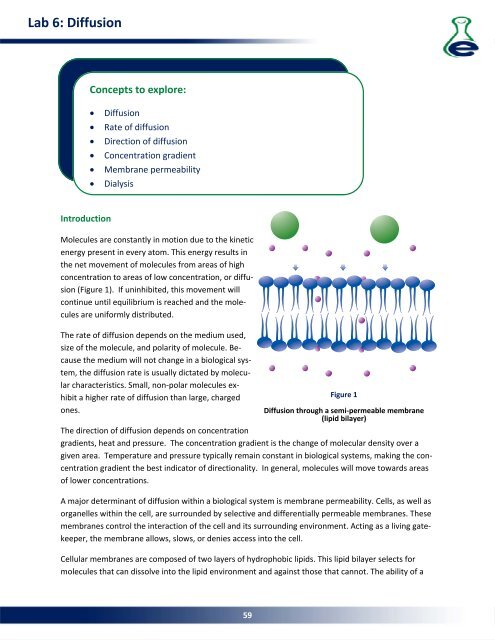Lab 15: Population Genetics - eScience Labs
Lab 15: Population Genetics - eScience Labs
Lab 15: Population Genetics - eScience Labs
You also want an ePaper? Increase the reach of your titles
YUMPU automatically turns print PDFs into web optimized ePapers that Google loves.
<strong>Lab</strong> 6: Diffusion<br />
Concepts to explore:<br />
<br />
<br />
<br />
<br />
<br />
<br />
Diffusion<br />
Rate of diffusion<br />
Direction of diffusion<br />
Concentration gradient<br />
Membrane permeability<br />
Dialysis<br />
Introduction<br />
Molecules are constantly in motion due to the kinetic<br />
energy present in every atom. This energy results in<br />
the net movement of molecules from areas of high<br />
concentration to areas of low concentration, or diffusion<br />
(Figure 1). If uninhibited, this movement will<br />
continue until equilibrium is reached and the molecules<br />
are uniformly distributed.<br />
The rate of diffusion depends on the medium used,<br />
size of the molecule, and polarity of molecule. Because<br />
the medium will not change in a biological system,<br />
the diffusion rate is usually dictated by molecular<br />
characteristics. Small, non‐polar molecules exhibit<br />
a higher rate of diffusion than large, charged<br />
ones.<br />
Figure 1<br />
Diffusion through a semi‐permeable membrane<br />
(lipid bilayer)<br />
The direction of diffusion depends on concentration<br />
gradients, heat and pressure. The concentration gradient is the change of molecular density over a<br />
given area. Temperature and pressure typically remain constant in biological systems, making the concentration<br />
gradient the best indicator of directionality. In general, molecules will move towards areas<br />
of lower concentrations.<br />
A major determinant of diffusion within a biological system is membrane permeability. Cells, as well as<br />
organelles within the cell, are surrounded by selective and differentially permeable membranes. These<br />
membranes control the interaction of the cell and its surrounding environment. Acting as a living gatekeeper,<br />
the membrane allows, slows, or denies access into the cell.<br />
Cellular membranes are composed of two layers of hydrophobic lipids. This lipid bilayer selects for<br />
molecules that can dissolve into the lipid environment and against those that cannot. The ability of a<br />
59
















